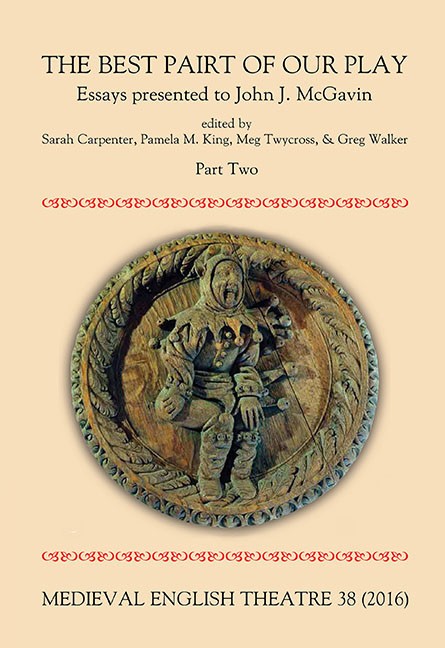 Medieval English Theatre 38
Medieval English Theatre 38 Book contents
- Frontmatter
- Contents
- Editorial
- The Funeral of Walter Scott, First Earl of Buccleuch: A Grand Ceremonial Occasion
- The Bright Star of the North: James I and his English Coronation
- ‘Ye know eek that in forme of speche is change’: Chaucer, Henryson, and the Welsh Troelus a Chresyd
- Playing the Crucifixion in Medieval Wales
- ‘My Boy shall Knowe Himself from Other Men’: Active Spectating, Annunciation, and the St John's College Narcissus
- ‘I Speke so Miche to Ȝow’: Authority, Didacticism, and Audience Address in Middle English Sermons and Morality Plays
- Early English Spectatorship and the ‘Cognitive Turn’
- The Theatre of the Mind in Late-Medieval England
- Poetics and Beyond: Noisy Bodies and Aural Variations in Medieval English Outdoor Performance
- Women and the Performance of Libel in Early-Modern
- Abraham Sacrifiant
- Miscellaneous Endmatter
‘My Boy shall Knowe Himself from Other Men’: Active Spectating, Annunciation, and the St John's College Narcissus
Published online by Cambridge University Press: 20 April 2017
- Frontmatter
- Contents
- Editorial
- The Funeral of Walter Scott, First Earl of Buccleuch: A Grand Ceremonial Occasion
- The Bright Star of the North: James I and his English Coronation
- ‘Ye know eek that in forme of speche is change’: Chaucer, Henryson, and the Welsh Troelus a Chresyd
- Playing the Crucifixion in Medieval Wales
- ‘My Boy shall Knowe Himself from Other Men’: Active Spectating, Annunciation, and the St John's College Narcissus
- ‘I Speke so Miche to Ȝow’: Authority, Didacticism, and Audience Address in Middle English Sermons and Morality Plays
- Early English Spectatorship and the ‘Cognitive Turn’
- The Theatre of the Mind in Late-Medieval England
- Poetics and Beyond: Noisy Bodies and Aural Variations in Medieval English Outdoor Performance
- Women and the Performance of Libel in Early-Modern
- Abraham Sacrifiant
- Miscellaneous Endmatter
Summary
In the collection of the Galleria Nazionale in Rome, in the Barberini Palace, there hangs an Annunciation painting by the Florentine artist Filippo Lippi. The painting has been dated on stylistic evidence alone to 1442: nothing is known of its original location, or of who commissioned or owned it; two figures who must be the donors appear in the bottom right hand of the painting, but they are unidentified. I am not the only medievalist to have observed that the bearded donor bears an historically accidental but nonetheless striking resemblance to John McGavin, for which reason the painting is my chosen starting point for this essay: a more scholarly reason is that the painting provides a study of staging, of spectatorship, and indeed of staging spectatorship — topics which have been so brilliantly addressed by John McGavin in his recent work. In this essay I will first consider what Lippi might help articulate about spectators, and then move to a consideration of spectating and audience in a largely-unstudied play exploring similar themes which was performed at St John's College, Oxford.
Lippi's Rome Annunciation presents, conventionally enough, the figure of the Virgin Mary, centre stage, an open book beside her, and a kneeling Gabriel offering her a lily, while the Holy Ghost descends in the form of a dove. The blue and red of Mary's robes are mirrored in the grey-blue and red of the angel's robes; Mary's right hand receives the lily from the angel's right hand, and the gestures of the two create a harmonious movement which draws the viewer's eye from the face of one to the face of the other; the angel humbly looks up to the Virgin, the Virgin's eyes are modestly downcast towards the angel. But the presence of other figures in this painting is less conventional. Donor figures are rare in Annunciations: they occupy ‘downstage left’ in Lippi's painting, and behind them but above them, upstage left, are two figures on a staircase whose identity is puzzling and whose presence is unprecedented.
Barnaby Nygren has suggested that the two figures on the staircase, one of whom appears to be male, and one female, are intended as ‘a parody or travesty of the encounter of Gabriel and Mary’.
- Type
- Chapter
- Information
- Medieval English Theatre 38The Best Pairt of our Play. Essays presented to John J. McGavin. Part II, pp. 68 - 83Publisher: Boydell & BrewerPrint publication year: 2017


